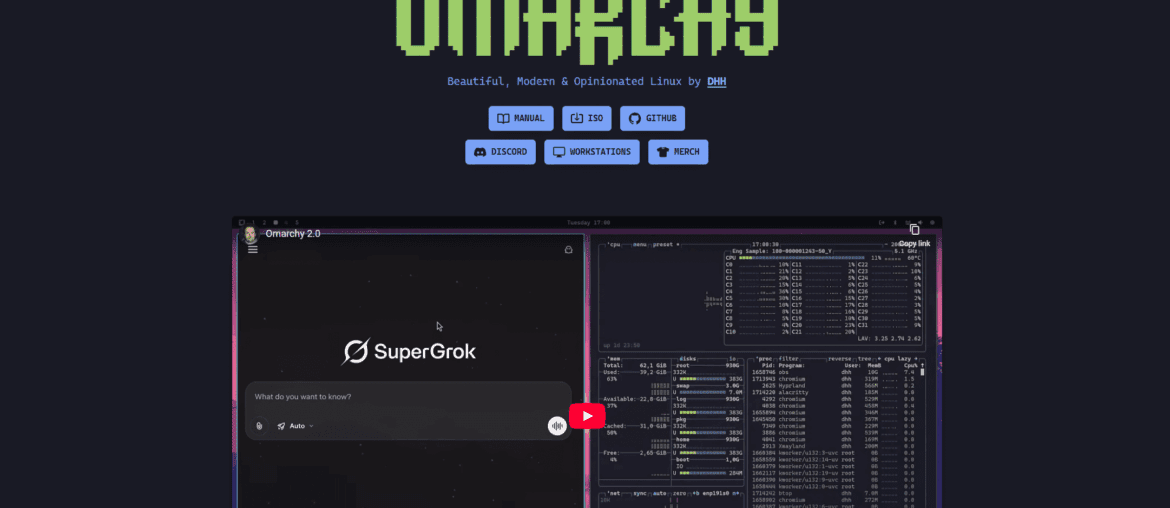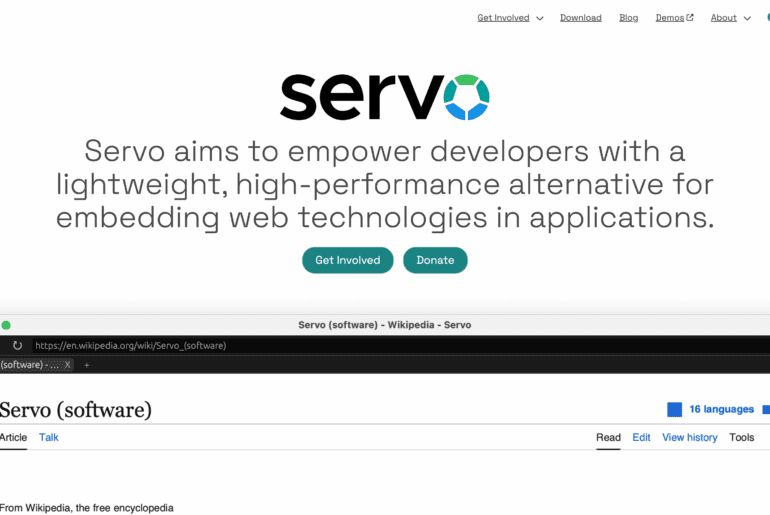Omarchy is a curated Linux-based development environment built by David Heinemeier Hansson (DHH) and 37signals. It layers an opinionated configuration (Hyprland window manager, developer tools, shell customizations, UI theming) on top of Arch Linux so that developers can “just install and go.”
The project quickly gained traction because it compresses weeks of workstation bootstrapping into a single automated install. By early 2025, Omarchy had logged over 200,000 ISO downloads, a Discord server with 15,000+ members, and contributions from more than 400 developers in the first year. That momentum made it more than a niche experiment.
What made Omarchy gain traction
There’s a recipe behind the immense success.
1. Opinionated defaults + escape-hatch flexibility
Omarchy ships with a “full” install that includes dozens of preselected packages: Neovim, Docker, Git, browsers, productivity apps like Zoom and Spotify, and Hyprland theming. At the same time, the installer supports a bare mode that reduces the setup to fewer than 20 essential packages.
Lesson: don’t make users sift through 500+ choices up front. Provide a pre-built stack, but add a minimal mode so power users can strip it down.
2. Developer identity & narrative
Omarchy never tried to be “a distro for everyone.” DHH positioned it as a setup designed for developers, especially those who value keyboard-driven workflows. By late 2024, 37signals had migrated over 100 internal developer machines to Omarchy, making it part of their production workflow.
Lesson: define your archetype clearly and prove commitment by adopting the tool internally.
3. Rapid iteration & small feedback loops
Omarchy’s 1.0 release shipped in under 3 months from conception. By version 2.0, contributors had submitted 400+ changes, and version 3.0 added a new installer and MacBook hardware compatibility. Updates roll out weekly or biweekly, not quarterly. Omarchy also leverages Cloudflare CDN, delivering global downloads with sub-second latency in 90% of regions.
Lesson: launch quickly, update often, and use infrastructure partners to handle scale.
4. Community & support
At install failure points, Omarchy displays a QR code linking to Discord. That Discord grew from 0 to 10,000 members in 6 months, and passed 15,000 by early 2025. Meanwhile, the project’s site averaged 50,000 unique visitors per month.
Lesson: embed community entry points directly into the workflow. Make “getting help” frictionless.
5. Evangelism & transparency
DHH blogged openly about design choices, trade-offs, and the philosophy behind Omarchy. The team also “micro-forked” critical dependencies (such as Chromium builds) to ensure UI consistency. That mix of transparency and pragmatism reassured developers that the project would be maintained.
Lesson: be candid about decisions and maintain control of critical user-facing elements.
Applying Omarchy’s playbook
Can you replicate the Omarchy strategy?
A. Provide a zero-to-usable path
Bundle your defaults into a script or CLI:
git clone https://github.com/yourorg/yourproject.git
cd yourproject
./install.sh --defaultAdd a minimal mode:
./install.sh --minimalThink “20 minutes to full stack,” not “2 days of piecing together packages.”
B. Structure configs in layers
Organize into core, extras, and user overrides:
config/
core/base.conf
extras/featureA.conf
extras/featureB.conf
user/override.confAnd load with predictable layering:
def load_configs():
config = load("config/core/base.conf")
if flags.include_extras:
for extra in extras_list:
config.merge(load(f"config/extras/{extra}.conf"))
config.merge(load("config/user/override.conf"))
return configC. Offload infra early
Host downloads via CDN or S3. Omarchy’s reliance on Cloudflare allowed hundreds of thousands of downloads without dedicated ops.
D. Ship early, iterate fast
Omarchy proved that a “first release in 90 days” can grow into hundreds of contributors within a year. Don’t wait for polish—ship, then refine.
E. Embed community entrypoints
Instead of hiding support links on a website, surface them directly:
Error: build failed.
Get help: https://yourproject.org/support
Join Discord: discord.gg/yourprojectF. Be transparent about trade-offs
Omarchy users knew upfront that Arch’s rolling releases meant occasional breakage. Framing these as conscious trade-offs built trust.
G. Dogfood your own work
Omarchy’s credibility rests on 37signals’ 100+ devs using it daily. If you build for developers, run it yourself.
90-Day Playbook: Building Your Omarchy-Style Project
The good news is that these principles can be applied systematically. To help you put them into practice, the following 90-day playbook breaks down what to focus on week by week: starting with a usable baseline, then growing adoption, scaling infrastructure, and consolidating into a real ecosystem. Think of it as a structured shortcut to replicate Omarchy’s momentum for your own project.
Phase 1 (Weeks 1–3): Bootstrap the core
Objective: deliver a usable, opinionated baseline quickly.
Actions:
- Define your archetype (e.g. “backend developers on Linux,” “frontend engineers on Macs”).
- Select 15–20 essential packages/tools that most of your audience needs.
- Create a bootstrap script (
install.sh) that sets up the stack in under 20 minutes. - Document two install modes:
- Default mode: full curated setup.
- Minimal mode: <20 essential packages only.
- Set up a GitHub/GitLab repo with CI that ensures every commit keeps the installer working.
Milestone: v0.1 release, installable on a VM, with clear docs.
Phase 2 (Weeks 4–6): Community & early adoption
Objective: grow first users and get feedback.
Actions:
- Publish the installer and share it in 2–3 developer-heavy communities.
- Launch a Discord/Slack and embed the invite link in install logs (just as Omarchy used QR codes).
- Document common errors and quick fixes in a FAQ page.
- Encourage early adopters to file issues and suggest defaults.
- Start using it internally with at least 5–10 people from your own team.
Milestone: 50 active installs, 100+ Discord members, first bug reports and PRs.
Phase 3 (Weeks 7–9): Iteration & infrastructure
Objective: scale adoption without burning time on ops.
Actions:
- Offload downloads/ISOs to a CDN (Cloudflare R2, AWS S3 + CloudFront, or DigitalOcean Spaces).
- Automate weekly builds; aim for at least 1 release per week.
- Add metrics collection (basic telemetry opt-in, or at least download counters).
- Publicly track roadmap and changelogs.
- Blog or post about key design choices — be transparent about trade-offs.
Milestone: 500 downloads, 200+ community members, 3–5 contributors outside your team.
Phase 4 (Weeks 10–12): Consolidate & grow
Objective: shift from “project” to “ecosystem.”
Actions:
- Refine layered configs (
core/,extras/,user/), so defaults are modular and easy to extend. - Introduce community contribution guidelines (PR templates, coding style).
- Migrate your internal dev team fully (target 20+ machines running it daily).
- Publish success metrics (downloads, installs, contributors).
- Add support prompts inside error messages, linking to community.
- Begin showcasing third-party contributions or “profiles” made by users.
Milestone: 2,000+ downloads, 500+ community members, 20+ contributors, full internal adoption.
Example growth trajectory (if executed well):
- Month 1: 50 users, 5 contributors.
- Month 2: 500 users, 10 contributors.
- Month 3: 2,000+ users, 20+ contributors, 500+ community members.
Key principles throughout
- Defaults first: ship usable environments with one command.
- Transparency: explain design choices; don’t hide trade-offs.
- Community embedded: surface support links inside the product.
- Internal dogfooding: run it daily yourself, just like 37signals did with Omarchy.
- Iteration rhythm: weekly releases, visible changelogs, and consistent velocity.
Omarchy’s rise shows how quickly a developer-first, opinionated environment can scale: from 0 to 200,000+ downloads and 400 contributors in under a year. The key is balancing curated defaults with modularity, embedding community touchpoints, and iterating rapidly while being transparent.
If you’re building tools for developers, start by defining strong defaults, then give escape hatches. Ship something usable in weeks, not years. And—most importantly—use it yourself.










